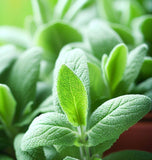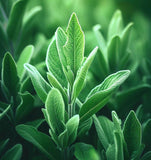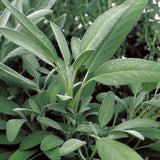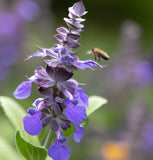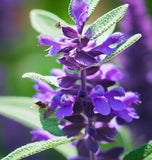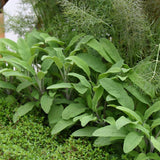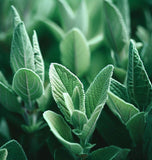Sage, Broadleaf (Salvia officinalis)
Sage, Broadleaf (Salvia officinalis) is a variety of the perennial herb sage (Salvia officinalis). It is a member of the Lamiaceae family and is widely cultivated and utilized for culinary, medicinal, and ornamental purposes.
Broadleaf sage shares many characteristics with its counterpart, Italian sage, but it is known for its larger and wider leaves. The leaves are gray-green in color, velvety, and have a slightly textured surface. They possess a strong, aromatic fragrance and a slightly bitter, savory flavor.
In culinary applications, broadleaf sage is highly prized for its distinctive taste and aroma. It is commonly used in cooking to flavor a variety of dishes. The leaves can be used fresh or dried and are often added to stuffings, meat dishes, sausages, soups, and sauces. Broadleaf sage pairs well with poultry, pork, game meats, and roasted vegetables, enhancing their flavors with its robust and earthy profile.
Medicinally, sage has a long history of traditional use. It is believed to have antimicrobial, anti-inflammatory, and antioxidant properties. Sage tea, made by infusing sage leaves in hot water, is sometimes used for its potential benefits, such as soothing sore throats or relieving digestive discomfort. However, it's important to note that the medicinal use of sage should be done under proper guidance and consultation with a healthcare professional.
Aside from its culinary and medicinal uses, broadleaf sage can also be grown for its ornamental value. The plant produces small, purple-blue flowers that attract bees and butterflies, making it a beneficial addition to pollinator gardens.
Cultivating broadleaf sage requires well-drained soil, full sun exposure, and regular pruning to promote bushier growth. It can be grown in herb gardens, containers, or used as a border plant in gardens or landscapes.
Broadleaf sage, like other sage varieties, should be used in moderation due to its potent flavor. Pregnant women, individuals with certain medical conditions, or those on specific medications should consult a healthcare professional before using sage medicinally.
Overall, broadleaf sage is a versatile herb that adds a unique taste and aroma to various culinary creations. Its larger leaves, robust flavor, and potential health benefits make it a valuable addition to both the kitchen and the garden.
Botanical name : Salvia officinalis
Common name : Sage, Broadleaf
Life cycle : Perennial in Zones 4-9
Days to maturity : 80
Light requirement : Full sun
Planting time : Spring/Summer
Sowing method : Direct sow
Planting depth : ¼"
Plant spacing : 20"-24"
Ships : Year-round
Average seed per ounce : Approx. 3,500








